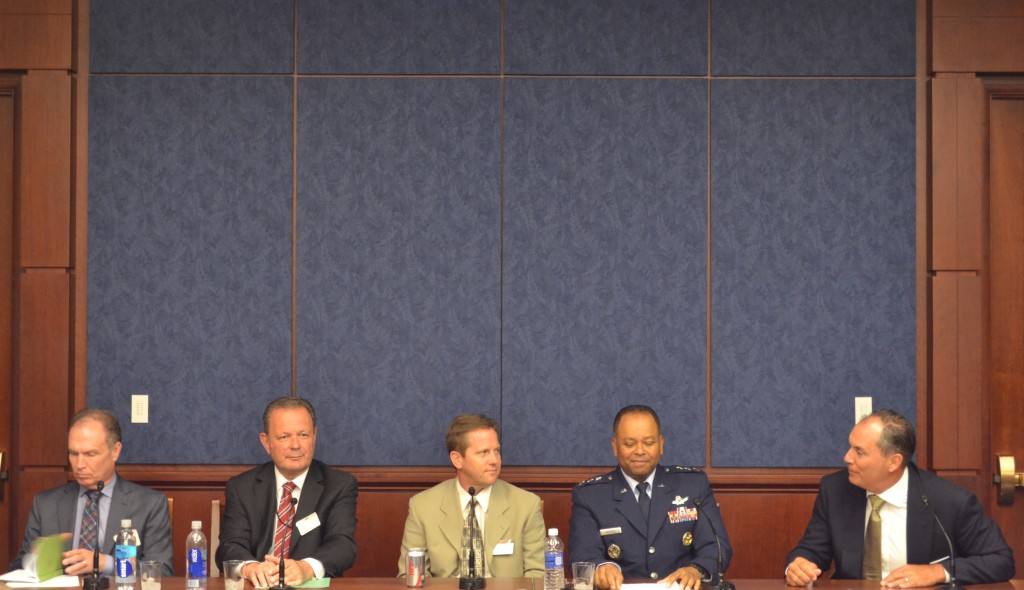On Tuesday, MDAA held a Congressional Roundtable Discussion on Future Ballistic Missile Defense Systems at the United States Capitol. The fifth in MDAA’s roundtable series, the event featured remarks by Lt Gen Samuel A. Greaves, Commander, Air Force Space and Missile Systems Center; Dr. Kelly Hammett, Chief Engineer, Air Force Research Lab (AFRL) Directed Energy Directorate; Mr. Richard Ritter, Program Executive, C4ISR, Missile Defense Agency (MDA); and Mr. Richard Matlock, Program Executive for Advanced Technology, MDA.
The remarks by our distinguished panel focused on the next steps in space-based surveillance, communication and tracking of ballistic missile threats, and the application of directed energy for boost phase missile defense from unmanned aerial vehicles (UAV). The panel also highlighted other areas of advancement in homeland missile defense, including investments in discrimination and a Multiple Object Kill Vehicle (MOKV) to maximize the effectiveness of our Ground Based Midcourse homeland missile defense system.
The following is a summary of some of the key takeaways from Tuesday’s discussion:
- Space assets perform a number of vital functions for missile defense, including missile warning and tracking, system communication and fire control. The advantages space provides in persistence and geographic reach make it an essential part of any sensor architecture that seeks to provide birth-to-death tracking.
- Future improvements to BMD and sensor systems will require a balance between improving current systems to trim their costs and innovating to push these systems into the future. To achieve this sort of balance, a comprehensive strategy is necessary to provide understanding of future requirements.
- Also essential to this task is collaboration across agencies and the commercial sector. Space assets can provide utility across a broad range of missions, making future investments more cost effective. Commercially hosted payloads for space assets represents another means to advance the provision of space capabilities.
- Directed energy weapons have made great strides in recent years, but challenges remain. The requirement to produce a megawatt power beam of sufficient aperture led to the development of large chemical lasers that use toxic substances. The AFRL and MDA are currently working to increase the power output of solid-state laser technology to reduce the size of the laser, which will expand the number of platforms it can be used on ensuring its practicality for boost phase defense. This would also allow the ability to mount lasers on UAV’s that can fly at altitudes that mitigate the environmental problems that plagued the Airborne Laser.
- To reduce the number of interceptors required for missile defense engagements, MDA is also working on a Redesigned Kill Vehicle (RKV) and the Multiple Object Kill Vehicle. The RKV would improve the confidence the warfighter has in an engagement by increasing the reliability of Ground Based Interceptors (GBI). The MOKV would allow a single GBI to engage multiple objects by releasing multiple kill vehicles, reducing the burden on discrimination sensors.
- Advances in discrimination can also reduce the number of credible targets that BMD systems must engage to be confident in mission success. Development of the Long Range Discrimination Radar serves this purpose, as do the successful tests of electro-optical sensors such as the Multi-Spectral Targeting system, which can operate on UAV’s to track missiles.
We would to thank the 80 people that attended including Senate and House staffers from both political parties, Representative Trent Franks, members of the press and the aerospace industry.
The tipping point for a generational technology change is near for missile defense. Informed and educated opinions create momentum for movement towards more effective and efficient missile defense systems that will make our world safer than it is today.

